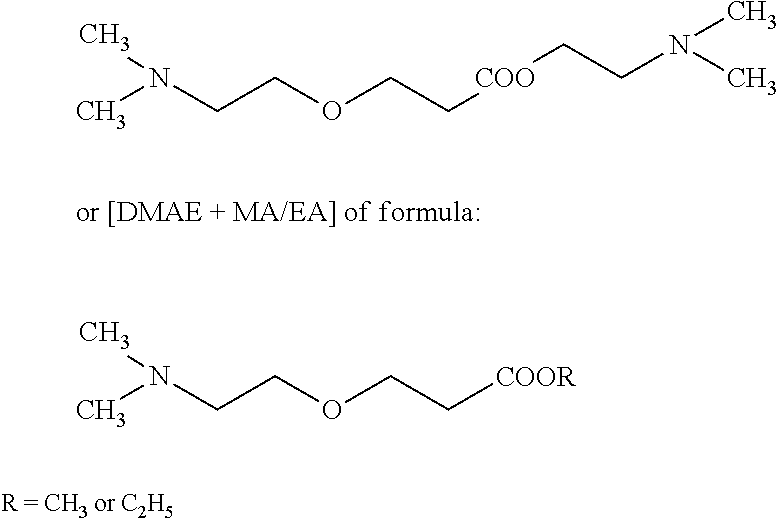Reclamation of noble products in a method for producing (meth)acrylic ester
a technology of methacrylic ester and noble products, which is applied in the direction of sustainable manufacturing/processing, organic chemistry, and separation processes, can solve the problems of significant losses of raw materials (especially dmae) and finished products, heavy losses cannot be envisaged, and michael adducts, so as to minimize the residual amount of michael adducts and improve thermal cracking. , the effect of avoiding the generation of impurities
- Summary
- Abstract
- Description
- Claims
- Application Information
AI Technical Summary
Benefits of technology
Problems solved by technology
Method used
Image
Examples
example 2 (
According to the Invention)
[0124]Example 1 was reproduced, replacing the compound Nalco® EC3368A with diethyl phthalate from Sigma Aldrich.
[0125]The subsequent treatment is similar to example 1.
[0126]The following were recovered:[0127]Distillate: 155 g[0128]Final residue: 133 g
[0129]The composition by weight of the distillate is:[0130]DMAE: 23.7%[0131]ADAME: 57.2%[0132]APA: 6.52%[0133]EA: 0.84%[0134]Methanol: 0 ppm[0135]Other heavy products: q.s. 100%
[0136]There is minimal fouling of the reactor, the final residue is viscous but does not solidify at room temperature. Moreover, the use of diethyl phthalate as fluxing / dispersing agent made it possible to avoid the formation of methanol in the distillate, which can thus be recycled without generating impurities in the process for synthesizing ADAME.
example 3 (
Continuous, Comparative)
[0137]A heavy fraction from an ADAME synthesis was introduced by means of a membrane pump into a glass reactor consisting of a thermosiphon reboiler. The feed flow rate is regulated by measuring the weight of residue in the tank. The reboiler is heated by means of a jacketed oil bath with a power of 160 W in order to minimize the skin temperature. The assembly is lagged and the heating temperature is adjusted to have the required temperature in the reboiler. At the top of the reboiler, a column element equipped with a multiknit element serving as demister has been added.
[0138]The bottom fraction was recovered by overflowing into the reboiler then taken up by a pump to be directed towards a receiver.
[0139]The operations were carried out under reduced pressure (50 mbar) and with nitrogen bubbling.
[0140]The composition by weight of the heavy fraction introduced is as follows:
[0141]DMAE: 5%
[0142]ADAME: 21.6%
[0143]APA: 35.7%
[0144]EA: 0.4%
[0145]q.s. 100%: heavy pro...
example 4 (
Continuous, According to the Invention)
[0174]Example 3 was reproduced with a heavy fraction of the following composition:
[0175]DMAE: 10.3%
[0176]ADAME: 15.3%
[0177]APA: 22.1%
[0178]EA: 0.08%
[0179]Absence of methanol.
[0180]q.s. 100%: heavy products+catalyst+inhibitors.
[0181]The compound Nalco® EC3368A was replaced by diethyl phthalate (5000 ppm).
[0182]The operating parameters of the micropilot plant are as follows:[0183]Feed flow rate: 200 g / h[0184]Residence time: 90 min[0185]Reboiler temperature: 180° C.
[0186]After one hour of reaction, 125 g of distillate and 75 g of final residue were recovered.
[0187]The composition by weight of the distillate is:[0188]DMAE: 19.9%[0189]ADAME: 68.2%[0190]APA: 0%[0191]EA: 1.46%[0192]Absence of methanol.
[0193]The composition by weight of the residue is:[0194]DMAE: 8.9%[0195]ADAME: 0.9%[0196]APA: 8.6%[0197]EA: 0.005%[0198]Absence of methanol.[0199]q.s. 100%: heavy products+catalyst+inhibitors.
[0200]Weight Balance:[0201]ADAME: from 30.6 g present in the f...
PUM
| Property | Measurement | Unit |
|---|---|---|
| viscosity | aaaaa | aaaaa |
| viscosity | aaaaa | aaaaa |
| temperature | aaaaa | aaaaa |
Abstract
Description
Claims
Application Information
 Login to View More
Login to View More - R&D
- Intellectual Property
- Life Sciences
- Materials
- Tech Scout
- Unparalleled Data Quality
- Higher Quality Content
- 60% Fewer Hallucinations
Browse by: Latest US Patents, China's latest patents, Technical Efficacy Thesaurus, Application Domain, Technology Topic, Popular Technical Reports.
© 2025 PatSnap. All rights reserved.Legal|Privacy policy|Modern Slavery Act Transparency Statement|Sitemap|About US| Contact US: help@patsnap.com


